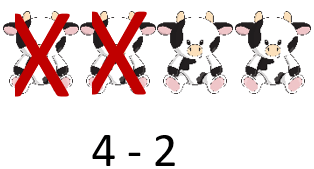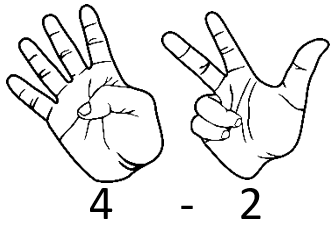Subtraction Worksheets
What is Subtraction? We all know that mastering addition is easier than grasping the concept of subtraction. Children can quickly put two things together to obtain a sum but they struggle with taking away one thing from another. Finding differences between values forms the foundation of many advanced mathematical concepts. Therefore, before they hop on complex concepts, it is necessary that they have a firm grip on finding a basic difference. In mathematics, subtraction is defined as taking away one thing from another. After we process this operation, what remains in the group is less than what was present before the calculation was processed. For example, If you take 3 away for 5 you will be left with 2. To express it mathematically, 6 - 4 =2 A simple subtraction problem usually has three parts. The part from which something is being taken away is known as minuend. The part which is being taken away is known as a subtrahend. The part that you are left with is known as difference. For example, 6 - 4 = 2, the number 6 is the minuend, 4 is the subtrahend and the number 2 is the difference. The worksheets and lessons that you will find here are found mostly mixed in with addition operations in our basic math skills sheets. Those operations are direct opposites of one another and it is always good to make that concept concrete for students.
- Borrowing and Regrouping - Students learn how to share the value between places.
- Decimal Subtraction - For most students paying attention to where the decimal point is, should be where they start.
- Decomposing Numbers Up To 20 - We show students remove values from a number in mirror subtraction skills.
- Fixed Integer Differences to 12 - A nice method to help you practice.
- Learning To Subtract - The most primitive form of this skill. This should be your starting point.
- Math Fact Families - We show how three values interrelate through a variety of options.
- Missing Digit Subtraction - A nice way to progress towards algebra.
- Number Line Subtraction - Students can see, through the use of a number line, the flow of a difference being calculated.
- Picture Based Differences - We forget about numbers and cross out values until we find out what is left over.
- Rapid Fire Horizontal Subtraction Math Facts - This means they are orientated in a left to right manner.
- Rapid Fire Vertical Subtraction Math Facts - You guessed it; they are layer one on top of the other in this section.
- Relating Addition and Subtraction (Fact Families) - We just focus on those two operations. It is good to see the interrelation of those two operations.
- Single Digit Subtraction - No greater than nine and no less than one.
- Subtracting Numbers with Figures - These are geometric figures, to be fully accurate.
- Subtraction and Unknown Addends (to 20) - Again, one step towards algebra problems.
- Subtracting with Dots - The dots could also be considered blocks by some.
- Simple Subtraction Word Problems - All the operations are differences in these story problems.
- One Digit from Two Digits Only - Some borrowing and regrouping are required on these problems.
- Two Digits Only - Eventually we hope students can perform these operations in the head.
- Two Digit from Three Digits Only - Learn how to find these common calculations.
- Three from Three Digits Only - You may need to borrow and regroup twice with these problems.
- Mixed Number Subtraction - We work to improve and review our skills with this topic.
- Four Digits Only - We start getting into larger values.
- Five Digits Only - Time to work with large differences.
Mixed Operations Worksheets
- Add and Subtract Within 1000 - A nice review of both related operations.
- Add and Subtract Multi-Digit Whole Numbers - These are for practicing your math facts.
- Adding and Subtracting Within 20 - These are for younger students.
- Addition and Subtracting to 5 - As basic as it gets.
- Addition and Subtraction Word Problems - We teach students to look for keywords that indicate math operations.
- Addition and Subtraction of Integers Worksheets - We work with a wide range of integers.
- Fluently Adding and Subtracting Double Digits - At this point, we are trying to commit them to memory.
- Mental Addition and Subtraction of 10s or 100s - Just remove one value for that place.
- One and Two Step Addition and Subtraction (Up to 100) Word Problems - We start to progress more towards critical thinking problems.
- Scientific Notation Addition and Subtraction - We show you techniques to help make it a cinch.
Tips For Teaching This Skill
Before we get going on this topic let me just remind you of the parts of subtraction. It will be helpful as you read further. Problems follow the model of:
Minuend - Subtrahend = Difference
We normally approach this basic concept with students in first grade. Collective our staff has taught first grade for over 100 years. So we all got together and discussed the best practices for teaching this skill to students at that age. Here is what we find works:
Always Start with Visuals - This is the immediate point that all of us agreed on. You should always approach this skill as a takeaway method. This is where we give students a problem and model it with objects. We do find that students do better when the numbers of the problem are found below the objects. This probably because it is easier to visually isolate the numbers when they are beneath objects rather than above them. Here is an example of a problem: 4 - 2. We will find a fun object that youngsters will be engaged with. We will use cute toy cows in our example. We teach them that your minuend (4) is the number of baby cows you would start with. Your subtrahend (2) is the number cows that you need to take away. We encourage you to use red slashes to serve as the cross out. We also encourage you to always have them cross out the objects that are most left. We find that this is much easier for them to track long term. So the problem 4-2 would be modelled as:

We would then teach them determine the difference by simply counting the number of left-over objects. Some of our teachers prefer starting by using manipulatives and others like visuals such as pictures. Everyone agrees that you will need to use both manipulatives and pictures before you move to anything else. A great manipulative to consider is having students model problems by using their fingers. Remind yourself that you only go as high as 5, but you can put partners together and go to 10. Here is that same problem modelled with fingers.

Number Line - Once students have the basic concept through manipulatives and images the natural progression is to use a number line and teach them to count backwards. The minuend is our starting point. We then count backwards the number of times of the subtrahend.

This really helps them work on the concept that all this skill is composed of is counting in reverse. Once they have this foundation it is pretty easy to build off. You will then progress on to paper and pencil problems. We also encourage students to either by or make math facts cards and practice 5 to 10 minutes everyday until they are memorized. Even then students will need to still look at them once a week to keep it fresh in their memory.